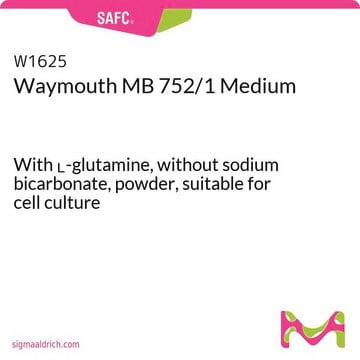DMS 153
95062827, human lung (liver metastasis), Not specified
Zaloguj sięWyświetlanie cen organizacyjnych i kontraktowych
About This Item
Kod UNSPSC:
41106514
Polecane produkty
product name
DMS 153, 95062827
pochodzenie biologiczne
human lung (liver metastasis)
tryb wzrostu
Semi-adherent aggregates
kariotyp
Modal no. 41-42
morfologia
Not specified
produkty
Not specified
receptory
Bombesin, Epidermal growth factor (EGF)
metody
cell culture | mammalian: suitable
powiązane choroby
metastasis
Warunki transportu
dry ice
temp. przechowywania
−196°C
Powiązane kategorie
Pochodzenie linii komórkowej
Human Caucasian lung small cell carcinoma, metastasis to liver
Opis linii komórkowej
DMS 153 was isolated from the liver of a 44 year-old male patient at autopsy who had been treated with cytoxan and methotrexate. The cells were identified as small cell carcinoma of the lung (SCLC) and secrete moderate quantities of calcitonin (CT) and calcitonin gene related peptide (CGRP). Production of adrenocorticotropin (ACTH), bombesin (BN), 17 β-estradiol and oxytocin-neurophysin (OT-NP) has also been reported. The expression of cell surface antigens Leu-7, HLA-DR, My 23 (defined by AML-2-23 monoclonal antibody), the AML-1-99 defined antigen and CR3 receptor (defined by the OKM antibody) has been shown. DMS 153 cells produce receptors for BN and epidermal growth factor (EGF) and are tumourigenic in athymic, nude mice.
Zastosowanie
Human lung tumour model
Profil DNA
STR-PCR Data:
Amelogenin: X,Y
CSF1PO: 10
D13S317: 13
D16S539: 12,13
D5S818: 12
D7S820: 8,10
THO1: 7,9.3
TPOX: 11
vWA: 14,15
Amelogenin: X,Y
CSF1PO: 10
D13S317: 13
D16S539: 12,13
D5S818: 12
D7S820: 8,10
THO1: 7,9.3
TPOX: 11
vWA: 14,15
pożywka hodowlana
Waymouth′s MB 752/1 + 2mM Glutamine + 10% Foetal Bovine Serum (FBS) (Heat Inactivated).
Rutyna subkultury
Split sub-confluent cultures (70-80%) 1:3 i.e. seeding at 2-4x10,000 cells/cm2 using 0.25% trypsin or trypsin/EDTA; 5% CO2; 37°C.Cells grow in large clumps.
Inne uwagi
Additional freight & handling charges may be applicable for Asia-Pacific shipments. Please check with your local Customer Service representative for more information.
Certyfikaty analizy (CoA)
Poszukaj Certyfikaty analizy (CoA), wpisując numer partii/serii produktów. Numery serii i partii można znaleźć na etykiecie produktu po słowach „seria” lub „partia”.
Masz już ten produkt?
Dokumenty związane z niedawno zakupionymi produktami zostały zamieszczone w Bibliotece dokumentów.
Nasz zespół naukowców ma doświadczenie we wszystkich obszarach badań, w tym w naukach przyrodniczych, materiałoznawstwie, syntezie chemicznej, chromatografii, analityce i wielu innych dziedzinach.
Skontaktuj się z zespołem ds. pomocy technicznej

